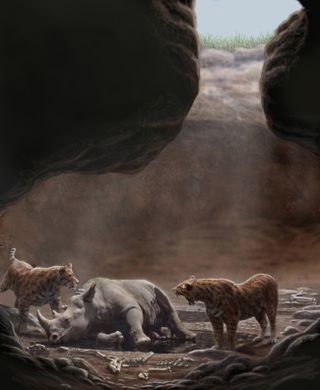
A cavern in Spain may have lured ancient carnivores to their deaths by offering the promise of food and water, new research suggests.
The new study, published today (May 1) in the journal PLOS ONE, may explain how the carcasses of several carnivore species, including saber-toothed cats and "bear dogs," wound up in an underground cavern millions of years ago.
"Only the carnivores were daring enough to enter," said study co-author M. Soledad Domingo, a paleontologist at the University of Michigan. "But they were unable to make their way out." [See Images of Cave of Death & Ancient Carnivores]
Surprise discovery
In 1991, miners drilling about 18.7 miles (30 kilometers) outside Madrid, Spain, uncovered animal bones and called in local paleontologists to excavate. They uncovered a series of underground caverns full of animal fossils — including the remains of red pandas, bear dogs and saber-toothed cats, as well as ancient animals related to modern elephants, giraffes, rhinoceroses and horses. To date, nearly 18,000 fossils have been recovered from the area.
The so-called Cerro de los Batallones caves formed between 9 million and 10 million years ago in a process known as piping, where sediment falls into cracks or fissures in the surface, carving out hollow spaces in the soft, claylike Earth. Unlike other "pipes" formed in clay that quickly disappear, however, the holes stayed open longer because the area also contained a harder type of rock to buttress the burgeoning caves.
Exactly what happened to the animals, however, remained a mystery.
Sign up for the Live Science daily newsletter now
Get the world’s most fascinating discoveries delivered straight to your inbox.
Cave of death
To solve the mystery, Domingo and her colleagues systematically analyzed all the bones discovered in the bottom level of the site, called Batallones-1. The cave contained an unusually high proportion of carnivores, some of which were completely unknown before the cave's discovery, Domingo told LiveScience.
The researchers found that nearly 98 percent of the large-mammal fossils were of carnivores, many of them healthy young adults. They also studied the orientation of the skeletons in the cave and the lack of trample marks.
Based on these findings, the team concluded that the cave probably had a visible opening in the ground, into which the herbivores may have occasionally fallen. (For instance, the cave contains a complete rhinoceros skeleton.) However, most of the herbivores were smart enough to avoid the trap.
But young-adult carnivores willingly entered the cave, possibly lured by the scent of food or water. The unlucky animals became trapped and died (likely from starvation), and the scent of their rotting carcasses lured other carnivores into the caves, and to their deaths.
"We think that the carnivores were getting trapped, and then they became additional food for another coming carnivore," Domingo said.
The researchers still don't know how long the cave was open before flooding brought fresh material to cover it up. And the findings only apply to one cavern at the site — scientists still need to do further studies to determine how herbivores wound up in the upper levels of the cave complex.
Follow Tia Ghose on Twitter @tiaghose. Follow LiveScience @livescience, Facebook & Google+. Original article on LiveScience.com.

Tia is the managing editor and was previously a senior writer for Live Science. Her work has appeared in Scientific American, Wired.com and other outlets. She holds a master's degree in bioengineering from the University of Washington, a graduate certificate in science writing from UC Santa Cruz and a bachelor's degree in mechanical engineering from the University of Texas at Austin. Tia was part of a team at the Milwaukee Journal Sentinel that published the Empty Cradles series on preterm births, which won multiple awards, including the 2012 Casey Medal for Meritorious Journalism.
Most Popular




